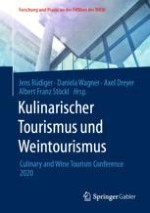Zusammenfassung
Essen und Trinken kann in unserer heutigen Zeit als ein zentraler Aspekt der Gesellschaft bezeichnet werden und somit ist es nicht verwunderlich, dass die Kulinarik auch zunehmend ein wesentlicher Bestandteil des Tourismuserlebnisses geworden ist. Mit diesem wachsenden Interesse am kulinarischen Tourismus lässt sich in den letzten Jahren zudem eine Entwicklung beobachten, bei dem das Thema Nachhaltigkeit eine zentrale Position einnimmt. Dies ist beispielsweise erkennbar an einer steigenden Nachfrage nach regionalen und lokalen Produkten sowie nach einer authentischeren Küche, aber auch anhand kulinarischer Trends wie zum Beispiel ‚Native Food‘ oder ‚Nature Food‘. Tourismusdestinationen versuchen diese Potenziale zu nutzen, um ein nachhaltiges Instrument zur Attraktivitätssteigerung der Destination und Abgrenzung zur Konkurrenz zu etablieren. Zudem können mittels kulinarischer Erlebnisse bestimmte Zielgruppen angesprochen werden. Als ein Beispiel kann hier der am schnellsten wachsende touristische Quellmarkt weltweit genannt werden: der asiatische und speziell der chinesische Markt. Gleichzeitig kann festgehalten werden, dass sich die Ansprüche der chinesischen Touristen bereits vor der COVID-19 Krise veränderten und diese Trends sich während des Jahres 2020 noch verstärkt haben (Arlt, Welcoming the new Chinese outbound tourists. Guest relationships with Chinese visitors in the 2020s. COTRI, Hamburg, 2020). Die Zahl der ‚Erstreisenden‘ verringert sich, stattdessen verfügt ein wachsender Anteil der chinesischen Auslandstouristen über Reiseerfahrung. Diese neue Zielgruppe sucht nach einzigartigen, naturbezogenen, authentischen und ‘instawürdigen’ Aktivitäten und kulinarische Erlebnisse können dabei eine wichtige Rolle spielen. Die Zielsetzung der hier vorgestellten Studie ist es, die Nachfrage nach traditionellen, kulinarischen Erlebnissen durch internationale Besucher aus Asien, insbesondere China, nach Australien und Deutschland zu untersuchen, um deren zukünftiges Potenzial für die Produktentwicklung einzuschätzen. Die Ergebnisse verdeutlichen dabei einen deutlichen Unterschied mit Blick auf die Nachfrage durch asiatische bzw. chinesische Reisende zwischen Westaustralien und Bayern und ein gegenseitiges Lernen kann eine langfristige Etablierung der regionalen Kulinarik für diesen Reisemarkt bedeuten.
Abstract
Food and drink can be described as a central aspect of society in today’s world, so it is not surprising that culinary has increasingly become an important part of the tourism experience. With this growing interest in culinary tourism, a development can also be observed in recent years in which the topic of sustainability takes a central position. This can be seen, for example, in the increasing demand for regional and local products and for a more authentic cuisine, but also in culinary trends such as ‘native food’ or ‘nature food’. Tourism destinations try to use these potentials to establish a sustainable instrument to increase the attractiveness of the destination and to differentiate it from the competition. In addition, specific target groups can be addressed by means of culinary experiences. One example is the fastest growing tourism source market worldwide: The Asian and especially the Chinese market. At the same time, it can be noted that the demands of Chinese tourists were already changing before the CoViD-19 crisis and these trends have intensified during 2020 (Arlt, Welcoming the new Chinese outbound tourists. Guest relationships with Chinese visitors in the 2020s. COTRI, Hamburg, 2020). The number of ‘first-time travellers’ is decreasing; instead, a growing proportion of Chinese tourists abroad have previous outbound travel experience. This new target group is looking for unique, nature-based, authentic and ‘instagramable’ activities. Culinary experiences can play an important role in this. The goal of the study presented here is to investigate the demand for traditional culinary experiences by international visitors from Asia, especially China, to Australia and Germany in order to assess their future potential for product development. The results show a clear difference in demand pattern from Asian and Chinese travellers between Western Australia and Bavaria, and reciprocal learning may support a long-term establishment of regional culinary experiences for this travel market.
